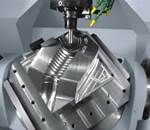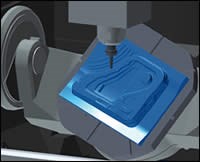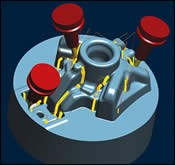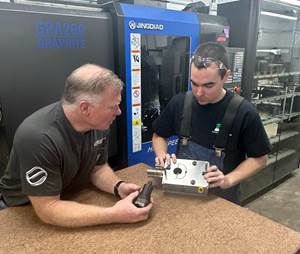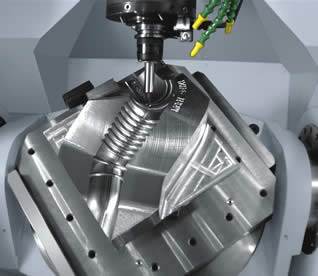How to Achieve Economical Five-Axis Milling
Although moldmaking has not had great incentives to invest in five-axis technology like the aerospace industry, there are still many reasons for moldmakers to adopt five-axis machining, and there are a few interesting software functions that help to make five-axis programming economical.
Though five-axis milling is broadly used in industry, it is still perceived too often in America to be a “special” technology and is not as widely embraced as in other technological markets such as central Europe or Japan. This article will explore some of the issues related to five-axis milling and may support those considering a strategic entry into five-axis milling.
Five-Axis Milling
Five-axis manufacturing techniques have long been used in the aerospace and power generation fields. This may be due to component geometry as found in gas turbine engines or automotive turbochargers, or complex and critical components such as landing gear on an aircraft. Or it may be an artifact of new computer-aided designs that use monolithic structural components that had previously been an assembly of welded sheet metal. The component produced with five-axis machining reduces the number of part numbers in the customer’s product and the assembly labor to produce the finished product. In aerospace, the engineering components requiring five-axis machining often have a lower weight, which is a critical performance criteria. Unrelated to actual manufacturing cost, these all improve product performance and economics.
But the moldmaking world has not had the same incentives to invest in five-axis technology and it lags behind their aerospace manufacturing brethren. In moldmaking, the shapes may not be as complex as in an aircraft engine (allowing easy extraction from the mold), weight is not a critical factor, and component production quantities do not reward productivity gains as they do in serial aerospace production. Yet there are still many reasons for moldmakers to adopt five-axis machining. Traditionally, five-axis machining offers one or more of the following benefits:
- Reduce setups and increase quality for multi-side machining
- Provide access to complex geometry
- Allow shorter tooling or tapered cutters that can be tilted away from steep-walled surfaces
A side benefit of the improved tooling is that small fillet radii near steep walled surfaces that may be difficult to machine with three-axis and that may have required a supplemental EDM process, can now be machined on one machine—and with one setup—by implementing five-axis technology.
Key Components to a Five-Axis System
Situations like this begin to draw a picture that five-axis milling can be economical in broader applications. In the previous examples, many part numbers (structural example) that impact drafting, PLM, assembly and quality disciplines, in addition to manufacturing; and, many process steps (steep wall example) that come from additional machine setup, additional fixturing, zero-point referencing and additional technology steps (possibly through outsourcing) for EDM were saved.
Today’s competitive market requires shorter cycle times and emphasizes smaller outsource vendor pools. Each supplier must thus become vital by being able to supply both standard and complex parts.
American business has much shorter time windows than European or Japanese companies. This focus on balance sheets and quarterly reports to stock markets and analysts may have a negative impact with regard to capital investments.
But you no longer need to be an early adapter to implement five-axis technology. The key components to a five-axis system include a milling machine, CNC controller (supplied with the machine), cutters and holders and CAM software (including postprocessor and simulation). Nearly even machine shop today has CNC equipment and probably has a broad understanding of most of these technologies today.
Software Functions Make Five-Axis Programming Economical
Most of the five-axis “magic” is managed by software in the CNC control and CAM software systems. The machine tool should be selected for sizes, speeds and capacities. And five-axis machine costs are coming down, and quality is improving with the implementation of CAD and simulation in the design process. However, there are a few interesting software functions that help to make five-axis programming economical.
CNC Control Functions
Most CNC controls have a utility function called tool center point management. Depending on the control manufacturer, this function may be named RTCP, TCPC or TCPM. The utility performs many functions with similar behavior no matter the controller. The key function performed by tool center point management systems is to allow the CNC control to accept fixture offsets and adjust NC data—on the fly—while working in five-axis mode; thereby, allowing one set of post-processed data to work for an entire batch of parts.
The benefit is that an operator need not align a workpiece precisely to the rotary table centerline. A part can be mounted and probed, and the offsets from center can be loaded into the control registers and processed with the NC data during operation. This function can reduce idle time on a milling machine while mounting a part and have the machine tool focus on chip removal. This is a more economical approach than purchasing a secondary pallet and table to allow part mounting while the part on the first pallet is being machined.
Taken one step further, the tool center point management allows a series of parts to be mounted without being precisely located on the machine or without being precisely mounted relative to the remainder of the production lot. So not only can we reduce the labor for mounting parts and the machine idle time, this control function can reduce the cost and preparation time for mounting fixtures and otherwise non-critical mounting surfaces on the workpiece.
CAM Software Price Considerations
In addition to software impact on the economic return from the CNC control system, the CAM software used to generate NC code can greatly impact the performance and economics of five-axis milling. A cursory review of CAM software from the Internet or brochures, or at a major trade show, indicates that nearly all market participants offer five-axis technology today.
So how do you then choose a CAM software product? One factor might be price, and this would seem consistent with a view toward economic implementation of five-axis technology. However, the retail price of a software package is only a first cost and is not the true implementation cost. Studies have shown that the license fees may comprise 25 to 30 percent of the actual implementation costs, with the remainder attributed mainly to training costs and ramp-up costs (inefficient labor utilization until a user is fluent and performing with high productivity).
On this basis, the evaluation of software products may be very different. For example, some enterprise products have up to four weeks or more of training duration and may require additional systems consulting work. And this general training format may not guide a user’s implementation on their particular products and applications. A simpler system may be quick to learn, but the user may struggle to get good results from the system or not have technical capability to control the cutter as desired.
CAM Software Technical Considerations
But the larger impact on economic implementation of five-axis machining may be in the technical details of the selected software. Though nearly all software offers five-axis capaiblities, not all software is created equally.
Many customers take months or more to evaluate five-axis software products. So the answer to the question will not be found in the next few paragraphs. Each organization will have different requirements and will weigh various factors differently. But we list some key questions that can help guide a prospective purchaser to select an economical five-axis milling solution.
Key Questions to Ask Before Your Software Purchase
- Are there sufficient machining cycles or strategies?
- Can a user devise a manufacturing plan according to his experience and preferences, or will a limited set of machining
strategies dictate the machining process? - Can acquired knowledge be stored and reused in the future on similar parts by the same user or another programmer?
- Should three programmers spend the time or have the prerogative to select step-downs and other parameters for a
given material on a given machine. - How much time and potential scrap/rework can be saved by storing best practices not only for simple applications like
drilling but also for five-axis processes? - Does the software provide analytic and graphic collision detection? If only graphical, can the user effectively modify
programming parameters based on graphical observations? - Is orientation control limited to surface normals (plus lead/lag) or can it be easily applied to multi-surface mold shapes,
preferably with limited user interaction? - Is collision avoidance available in addition to collision detection to eliminate programming iterations?
- Can the avoidance mechanism bias the use of one rotary axis over the other (if they don’t have the same specifications)?
- Can the orientation control seek regions of 3+2 solution to provide more stable results where possible?
- Do NC postprocessors support advanced control functions?
- Can they utilize canned cycle functions on tilted workplanes or connect multi-axis hole patterns without repeatedly moving
to a safety retract?
These functions can support fine tuning at the machine, or can save air time between hole locations.
Summary
This article has presented a series of issues for prospective purchasers and questions to ask as they implement five-axis technology in an economical way. If you ask different questions, you get a different answer. Have you asked the right questions? Five-axis milling technology has been applied for many years in the aerospace field, so moldmakers are following a path already traveled and should embrace their future.
![]()
Related Content
Five-Axis Graphite Mill With Automation Debottlenecks Electrode Machining
Five-axis electrode cutting enabled Preferred Tool to EDM complex internal screw geometry on an insert that otherwise would have had to be outsourced.
Read MoreFive-Axis Vertical Mill Increases Mold Shop Capacity by Reducing Setups
Zero Tolerance now processes blocks — from squaring to waterline drilling to rough and finish milling — on a single five-axis CNC mill, reducing setups and moving blocks in/out of multiple machines without sacrificing accuracy and surface finish.
Read MorePrecision Meets Innovation at IMTS 2024
After attending IMTS, it's clear that the integration of advanced technologies is ready to enhance precision, efficiency and automation in mold manufacturing processes. It’s a massive event, so here’s a glimpse of what the MMT team experienced firsthand.
Read MoreHow to Eliminate Chatter
Here are techniques commonly used to combat chatter and guidelines to establish a foundation for optimizing the moldmaking process.
Read MoreRead Next
Improve Shop Competitiveness With Five-Axis Capability
The key to keeping work local, while still remaining profitable, is a willingness to evaluate and dramatically alter your shop’s processes by investing in new technology.
Read MoreAre You a Moldmaker Considering 3D Printing? Consider the 3D Printing Workshop at NPE2024
Presentations will cover 3D printing for mold tooling, material innovation, product development, bridge production and full-scale, high-volume additive manufacturing.
Read MoreHow to Use Continuing Education to Remain Competitive in Moldmaking
Continued training helps moldmakers make tooling decisions and properly use the latest cutting tool to efficiently machine high-quality molds.
Read More
